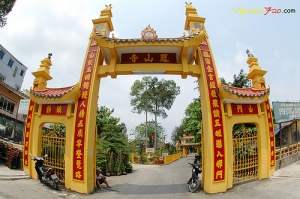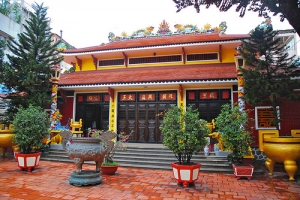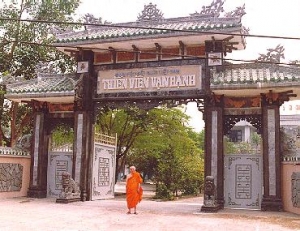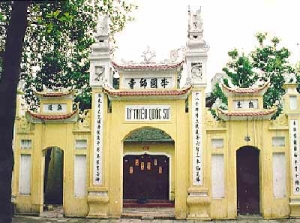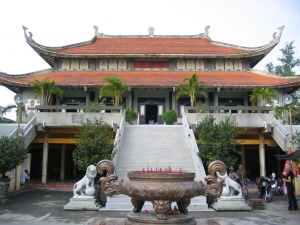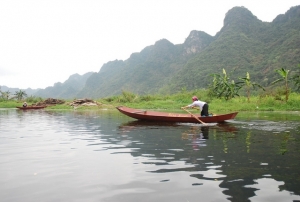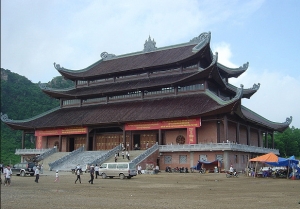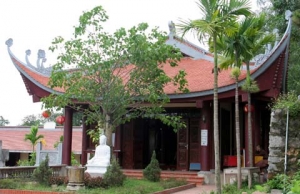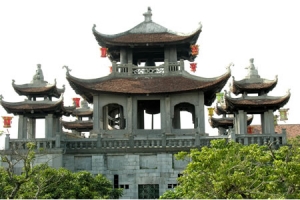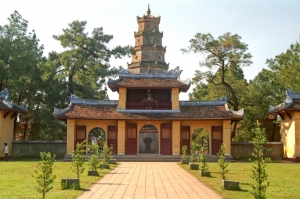
Asia Pacific Travel Team
Phung Son Pagoda
Phung Son Pagoda was established in the early 19th century by Bonze Lieu Thong. Since then, it has undergone two major restorations. Many statues found in the pagoda were created by a group of craftsmen from Sa Dec.
Location: Phung Son Pagoda is located at 1408 Duong 3 Thang 2, District 11, Ho Chi Minh City.
Characteristic: Phung Son Pagoda was established in the early 19th century by Bonze Lieu Thong. Since then, it has undergone two major restorations. Many statues found in the pagoda were created by a group of craftsmen from Sa Dec.
 Many years ago, it was decided that it should be moved to a different location. All of the ritual objects were loaded on to the back of a white elephant for transportation. On the way to the new site, the elephant slipped and all of the precious objects fell into a nearby pond. This event was interpreted as a sign that the pagoda should remain at its original location. All of the ritual objects were retrieved, except the bell, which locals say was heard ringing whenever there was a new or full moon up until a century ago.
Many years ago, it was decided that it should be moved to a different location. All of the ritual objects were loaded on to the back of a white elephant for transportation. On the way to the new site, the elephant slipped and all of the precious objects fell into a nearby pond. This event was interpreted as a sign that the pagoda should remain at its original location. All of the ritual objects were retrieved, except the bell, which locals say was heard ringing whenever there was a new or full moon up until a century ago.
A number of valuable statues, such as Di Da Tam Ton, Ngu Hien Thuong Ky Thu, a stone statue of Buddha covered with gold leaves, and a ceramic statue of Tieu Dien are also found in the pagoda. The surrounding area is an archaeological site from which many artifacts were excavated, such as a baked earthen head statues and ceramic items belonging to the Oc-Eo culture. The Ministry of Culture has recognized the pagoda as a historical and cultural relic. People pray three times a day from 4 to 5 am, 4 to 5 pm, and 6 to 7 pm.
Tran Hung Dao Temple
It was first erected in 1932 as a Buddhist pagoda bearing the name of Van An. In 1958, it was entirely rebuilt, featuring the architecture seen today, forming a T-shape with two-piled up roofs and eight curved corners adorned with dragon and phoenix figures.
Location: Tran Hung Dao Temple is at 36 Vo Thi Sau Street, District 1, Ho Chi Minh City.
Characteristic: It was first erected in 1932 as a Buddhist pagoda bearing the name of Van An. In 1958, it was entirely rebuilt, featuring the architecture seen today, forming a T-shape with two-piled up roofs and eight curved corners adorned with dragon and phoenix figures.
It is styled after northern Vietnamese temples and communal houses. Inside, there are many horizontal and vertical lacquered boards, as well as carved and meticulously inlaid incense tables. On the wall, there are pictures of Tran Hung Dao as he chased away Kublai Khan’s Mongol aggressors in the 13th century.
The greatest ceremonies at the temple occur over the New Year and on the 20th day of the eighth lunar month to celebrate Tran Hung Dao. The temple is open daily from 6 to 11am and from 2 to 6 pm.
Source TCDLVN
Van Hanh Monastery
It includes the imposing Tam Quan (three-entrance gate), the main court hall, Vietnam Buddhism Higher College office, the Institute of Buddhism Research office and the Translation Council of Vietnam Prayer Books office.
Location: Van Hanh Monastery is situated near the road between Phu Nhuan and Go Vap Districts.
Characteristic: It includes the imposing Tam Quan (three-entrance gate), the main court hall, Vietnam Buddhism Higher College office, the Institute of Buddhism Research office and the Translation Council of Vietnam Prayer Books office.
Van Hanh Monastery regularly welcomes international Buddhist delegations and other foreign visitors. Devotees from all over the country come to this monastery to celebrate Buddha’s birthday and to take part in preaching sessions.
Source: Vietnam Nation Administration of Tourism
Ly Quoc Su Pagoda
Ly Quoc Su Pagoda worships a Buddhist Monk of the Ly Dynasty (the 10th - 12th centuries). This Monk, whose full name was Nguyen Chi Thanh, was born on 1066 in Dien Xa Village, Gia Vien District in Ninh Binh Province in the reign of King Ly Thanh Tong.
Location: Ly Quoc Su Pagoda is at 50 Ly Quoc Su Street, Hoan Kiem District, Hanoi.
Characteristic: Ly Quoc Su Pagoda worships a Buddhist Monk of the Ly Dynasty (the 10th - 12th centuries). This Monk, whose full name was Nguyen Chi Thanh, was born on 1066 in Dien Xa Village, Gia Vien District in Ninh Binh Province in the reign of King Ly Thanh Tong.
In 1077, at the age of 11, Nguyen Chi Thanh began practicing for the Buddhist monkhood and was taught by Tu Dao Hanh, a well-known monk. As the legend says, Monk Tu Dao Hanh was erudite in Buddhism and excellent in healing. He admired and respected Nguyen Chi Thanh's talent and virtue. In 1138, in his seventies, Monk Nguyen Chi Thanh cured King Ly Than Tong of a disease that many famous doctors had failed to do. For his respectful virtue and talent, he was given the title Ly Quoc Su by the King, which meant Great Monk and Merit Teacher of the nation.
for the Buddhist monkhood and was taught by Tu Dao Hanh, a well-known monk. As the legend says, Monk Tu Dao Hanh was erudite in Buddhism and excellent in healing. He admired and respected Nguyen Chi Thanh's talent and virtue. In 1138, in his seventies, Monk Nguyen Chi Thanh cured King Ly Than Tong of a disease that many famous doctors had failed to do. For his respectful virtue and talent, he was given the title Ly Quoc Su by the King, which meant Great Monk and Merit Teacher of the nation.
The King provided Ly Quoc Su with a serene residential quarter, which was situated next to Bao Thien Pagoda in the centre of Thang Long Capital, on a side of Luc Thuy Lake (Hoan Kiem Lake of today). This pagoda had a 12-storey tower. Apart from preaching Buddhist sutra for the monks and nuns, Ly Quoc Su taught medicine, prescription of medicines and demotic scripts to many people in the temple and surrounding areas. Skilled in bronze casting, Ly Quoc Su also trained many bronze casting craftsmen.
 That is why when he died at the age of 75 at Giao Thuy Pagoda in Nam Dinh in 1141, King Ly Anh Tong (holding power from 1138 to 1175) had a temple erected right on the ground of the residential quarter where Ly Quoc Su had lived. Throughout the country there are many pagodas worshipping both Buddha and Ly Quoc Su, who is considered the Saint of the bronze casting craft, such as Giao Thuy Pagoda in Nam Dinh and Keo Pagoda in Thai Binh.
That is why when he died at the age of 75 at Giao Thuy Pagoda in Nam Dinh in 1141, King Ly Anh Tong (holding power from 1138 to 1175) had a temple erected right on the ground of the residential quarter where Ly Quoc Su had lived. Throughout the country there are many pagodas worshipping both Buddha and Ly Quoc Su, who is considered the Saint of the bronze casting craft, such as Giao Thuy Pagoda in Nam Dinh and Keo Pagoda in Thai Binh.
Ly Quoc Su Pagoda was rehabilitated and redecorated many times with the biggest restoration being made in 1954. The cultural and historical treasure of this temple still remains Ly Quoc Su's statue, Buddha statues and statues of Monk Tu Dao Hanh and his mother and Monk Giac Hai. There is also the precious bell of Tu Chung, cast in the 19th century and a stone stele with inscriptions made in 1855 by Le Dinh Duyen, a famous man. The name of Ly Quoc Su was given to a 244 metre-long street running from Hang Bong to Nha Tho streets.
Vinh Nghiem Pagoda
Inaugurated in 1971, Vinh Nghiem Pagoda is the biggest pagoda in Ho Chi Minh City. Built in modern style, but the structure draws its inspiration from traditional Vietnamese culture and a touch of Japanese architectural style. The pagoda features a vast sanctuary and an eight-storey tower. On the first and fifth of lunar months, believers throng the pagoda to pay their respects, make offerings and pray for blessings.
Location: Vinh Nghiem Pagoda is located at 339 Nam Ky Khoi Nghia Road, District 3, Ho Chi Minh City.
Characteristic: Inaugurated in 1971, Vinh Nghiem Pagoda is the biggest pagoda in Ho Chi Minh City. Built in modern style, but the structure draws its inspiration from traditional Vietnamese culture and a touch of Japanese architectural style. The pagoda features a vast sanctuary and an eight-storey tower. On the first and fifth of lunar months, believers throng the pagoda to pay their respects, make offerings and pray for blessings.
 Vinh Nghiem Pagoda was constructed between 1964 and 1971 in the area of 8,000m² following the design of architect Nguyen Ba Lang.
Vinh Nghiem Pagoda was constructed between 1964 and 1971 in the area of 8,000m² following the design of architect Nguyen Ba Lang.
The Kwan-Yin Tower classic style of 35m seven-storey tower with strong Japanese influences was built with the assistance of the Japan-Vietnam Friendship Association. It is located on the left of the pagoda. This structure is the biggest of the Vietnam Buddhist Association.
A Devotee Relic four-storey Tower (Thap xa loi cong dong) with 25m high was erected behind the pagoda in 1982.
Perfume Pagoda (Chùa Hương) – “the first ranking Southern grotto”
“Perfume Mount is an ever wish/ With mountains, water, and clouds/ People always ask if this is the top-ranking cavern…” (extracted from “Perfume Mount passion” written by Chu Manh Trinh)

Overall view
Around 60 kilometers southwest of Hà Nội, Perfume Pagoda is one among the largest and unique religious sites in Huong Son Commune, My Duc District, old Ha Tay (or enlarged Hanoi), right banks of Day River, northern Việt Nam. It comprises a complex of pagodas and Buddhist shrines built into the limestone cliffs of Perfume Mount (Hương Sơn), scattering alongside the mountain up to the peak. The complex’s center is right inside Huong Tich cavern (or in other words, Inside Pagoda). Huge numbers of pilgrims flock to the site during Perfume Pagoda festival, which begins in the middle of the first lunar month and lasts until the middle of the third one (or from February till March) in order to pray for happiness and prosperity in the coming year. Also, it is a very popular opportunity for young couples to meet and for numerous budding romances to be formed. On this special occasion, a wide range of traditional cultural activities is incorporated. Perfume pagoda is not only a religious site, but a great sight-seeing spot in Vietnam as well.
Starting the pilgrimage
Coming to Huong Pagoda, what should not be left home is a good camera, since you will regret unless you catch all the snapshots of this fascinating nature drawings!
Bến Đục (Pier Duc)
The very first starting point of the pilgrimage is Ben Duc (Pier Duc). Normally, it takes more than 2 hours to go from Hanoi to Ben Duc. During the annual festival months, Ben Duc is packed with thousands of row boats used for shuttling visitors. For many visitors, this one-hour boat ride on the Yen Vi Stream from Pier Duc is actually the highlight of the trip, and inspiration sources of quite a few famous poets.
Suối Yến (Yen stream)
Yen stream flows between two mountains for 3 kilometers. Nevertheless, sitting on the boat, leisurely enjoying the surrounding landscape, you may feel that the stream is endless. Despite a facilitated road from Pier Duc to Perfume mountain, most people choose to use row boats on Yen Vi Stream (or Yen Stream), which is by far a much more romantic and scenic route to Huong Pagoda.
While traveling along Yen Stream, tourists pass by stunning landscape of blazing green rice paddles studded with jagged limestone mounts to the base of Huong Mountain. If you are on a boat there, you can easily see on your left the Phoenix Mountain, and Doi Cheo Mountain, which looks like an Indian python (Tran). Also on the left are Bung and Voi, the two mountains associated with interesting legends. On your right is Ngu Nhac mountain with the Trinh Temple where visitors stop and burn incense for the God of the Mountain. Before reaching Tro Wharf where the tour begins, the boat also passes by the Deo and Phong Su Mountains, Son Thuy Huu Tinh Cave, Trau Cave, Hoi Bridge, and Dau Valley.
Chùa Thiên Trù (Thien Tru Pagoda)

Stepping inland, there comes an interesting informal protocol for tourists! The first stop before climbing up to Huong Mount must always be a visit to Den Trinh, which means “registration shrine”. The next point of interest would be a visit to Thien Tru Pagoda (chuà Ngoài - Outer Pagoda), which was built in the 18th century under King Le Thanh Tong dynasty. “Thien Tru” means a heaven kitchen, derived from the imagination of the locals in this region, of which the rock formations in this area look like chefs busily working in the kitchen. Thien Tru Pagoda is famous for Thuy Tien tower, a granite monolith. On the right is Tien Son grotto, popular for five granite statues and various formations on the walls of the cave. Coming here, pilgrims have chances to admire the pagoda’s beauty and wonderful local landscapes.
Động Hương Tích (Huong Tich Grotto)
After more than one hour along the stream and visiting the initial ancient pagodas from the riverbank, now pilgrims would climb up hundreds of stone steps, and then down 120 stone steps to Huong Tich Grotto, literally meaning "traces of fragrance". The path to Huong Tich winds its way through magnificently luxuriant landscapes. The moss-grown Huong Tich Grotto came to life thanks to the most venerable Van Thuy Thien Tran Dao Vien Quang Chan Nhan, the Chief monk of Thien Tru Pagoda. In front of the cave lie stone stairs. Stepping down the 120-step stairs, tourists will find the inscription "The first-ranking grotto under the Southern Sky" in Han scripts, which are traces of Lord Tinh Do Vuong Trinh Sam's calligraphy in the 3rd lunar month of the year of the Tiger (Canh Dan -1770). Getting into the grotto, you will find a purely cool atmosphere in a dim light before figuring out naturally architectural works such as Dun Gao (Rice) rock, gold and silver trees, Girl and Boy Mountains (in the shapes of a girl and a boy), and so forth. Yet, what is noteworthy is the statue of Avalokitesvara carved out of emerald stone on a rocky lotus, constructed in 1793, under the Tay Son dynasty, and a 1.24m bronze bell, moulded in the 3rd Thinh Duc Year (1655). The unique carving art together with the extremely magnificient works of Nature makes the Huong Pagoda complex the top-revenued tourism destination among others in Ha Tay, and the foremost destination of Buddhists in particular and tourists in general.
Saying goodbye to Perfume Grotto, now tourists may choose to further go up to the top Mount by climbing up hundreds of stone steps, all worn smooth by passage of countless feet, or take a short rest and complete the pilgrimage.
These days, the Vietnamese believe that Huong Son is Buddha's Heaven due to its sacredness and 100% natural works of beauty. Quite a few tourists would like to come back this mysterious and sacred mountain annually for religious reasons on the one hand, and on the other hand, for the enchanting natural landscapes..
Bai Dinh, the biggest pagoda in ASEAN
ai Dinh Pagoda is famous for its great size and imposingness. The pagoda will be also set more record for the owner of the most Arhat Statues in ASEAN with 500 Arhat statues made of stone and stand higher than human’s head.

Located behind a range of limestone mountains in Gia Sinh Commune, Gia Vien District, Ninh Binh Province, the site with construction lying about in disorder and in the way, so it is difficult to imagine its beauty as well as its solemn to a pagoda in the true sense of the word as the tradition. However, its great size and imposingness can be felt by anybody when visiting it one time. Its back leans against the Bai Dinh Mountain with the height of 200m. The area for constructing Ba Dinh Pagoda is 80ha, which is located on the mass of “Bai Dinh Pagoda hallowed culture” belonging to Trang An Tourism Area. Currently, this mass is executing many items of Pagoda including Tam The (Past, Present and Future) Temple, Sanctuary and Bodhisatva Kwan Yin statue, Dharma Temple, Bell-tower, Three-door temple gate, and dormitory area for Buddhist monks, etc. In front of Pagoda valley, a hundred of excavators, bulldozers and power-shovels are digging land and build up a dike to make a huge semicircular lake, which will be taken water from the river crossing to create a landscape of “on shore and under boat” like the Yen Stream flowing under the foot of Huong Tich Pagoda
.
The most important emphasizing point of these great religion works are still Tam The Temple and Dharma Temple. The area of two Temples up to 1.000m2 (area of the main sanctuary of traditional pagodas is maximum about 150m2 because it is limited by compartments - stipulated by the length of wood beam). The height of Dharma Temple is up to 22m, it contains four achieving record statues inside.
Four statues - three bronze Tam The statues and one Great Buddha Sakyamuni statue - are the pride of “Owners” of Bai Dinh pagoda. Each statue of Tam The weighs 50 tons, 12m high, Great Buddha Sakyamuni statue with 16m high and weighs 100 tons, which are casted by the pure bronze bought from Russian, casted and installed by the famous Artisans of casting bronze statue in Y Yen, Nam Dinh. A “great bell” with the weight of 60 tons was casted and located on the top of hill on the way come to the main sanctuary. The Great Bell is so big that it is estimated if wanting to sound the bell, it will need a big log of wood and four puller the log of wood to prod into the bell.
The astonishing one is the “collection” of 500 Arhat statues on the hill in the right of Dharma Temple. The 500 Arhat statues with the height of 2.3m, carved by Ninh

Binh stone. According to the supervisor for executing at the site, Mr. Nguyen Xuan Truong - investor and his collaborator came to China to learn and take the sample drawings of 500 Arhat’s legend and brought to home country for the painters, carvers to make the sample statue of gypsum, after that the craftsmen carved the statues again by monolithic green stone. People in Gia Vien District joked that: only carving enough these 500 Arhat statues, the villagers in Ninh Van’s stone craft village, Hoa Lu (neighbor district) have got enough jobs security during the past two years.
Though the construction of Bai Dinh Pagoda has not yet finished, the reputation of this new Pagoda was far-resounding. The visitors received some information from the backstage “whisper in each other’s ears”, have come to burn incense before the bronze statues of Buddha which are still being covered by scaffolds. While far from the large site 2km, if sharp-sighted the passers will see a humble three-door temple gate loacated next the roadside. Through the three-door temple gate, turn to the small path rather slope, go up to the top of mountain we will see the Bai Dinh Pagoda (old), full of green moss and quiet. There is virtually none knowing to a “Great Buddhist Pagoda” will be going to set the record of Asean being executed at the site over there.
Ecologically and historically rich, the Bai Dinh Pagoda Mountain was recognised as a cultural and historical heritage site in 1997. Bai Dinh Pagoda will become the largest religious tourist centre in Viet Nam upon completion in 2010 to celebrate the 1,000th anniversary of Thang Long - Ha Noi.
As a great historical relics, Bai Dinh Pagoda cherishes both: enchanting scenery and deep history. Let’s give you a chance to enjoy the beauty...
Phat Tich Pagoda - The cradle of Vietnamese Buddhism
Phat Tich is an ancient pagoda at the foot of Phat Tich Mountain. Coming here, tourists can get a glimpse of the birthplace of Vietnamese Buddhism.
Phat Tich is the cradle of Vietnamese Buddhism. It was the first place where Indian Buddhism was introduced.
Also known as Van Phuc, the pagoda in Tien Du District, Bac Ninh was built between the 7th and 10th centuries and renovated throughout the years before its destruction in 1947 during the war against the French. Since it was important to Buddhist life, it was roughly rebuilt in 1958.
Along the moss-covered path to the main hall are two lines of stone horses, buffaloes, rhinos, elephants and lions on their knees, which are among a few vestiges of the ancient pagoda.
During the Ly Dynasty in 1057, a tower was built at the pagoda but it later collapsed, thus exposing what was described as the country’s largest Buddha statue, which is 1.85m high. It is a real treasure. There are also a dozen of lower towers said to hold the remains of senior monks.
Visitors can also see a giant stone statue of Buddha on the peak of Phat Tich Mountain, which took three years to build. The statue is 27m tall and weighs 3,000 tonnes, making it one of the largest stone statues in Southeast Asia.
Actually, the architecture of the pagoda is quite similar to that of others in northern Vietnam but it is worth dropping by it to get a glimpse of the birthplace of Vietnamese Buddhism.

Stone horses, buffaloes, rhinos, and lions on their knees in front of the main hall

The wooden gate to the main hall of the pagoda

The bronze bell and the drum (in the background) hung above the entrance to the pagoda

A side stone staircase to the pagoda
The elegant combination of Phat Diem Cathedral
Phat Diem Cathedral is a harmonious combination of traditional pagoda architecture of Vietnam mixed with the Gothic style of Christian architecture. It 's the center of Catholicism in north Vietnam and also a tourist site attracting foreign and domestic visitors.
Phat Diem Cathedral with Hoa Lu Ancient Capital, Tam Coc - Bich Dong, Bai Dinh Pagoda, Trang An, Cuc Phuong is the attractive destination of Ninh Binh province. Phat Diem Cathedral is located at Phat Diem Town Kim Son district. From Hanoi, we can take the national highway 1A passing over Phu Ly, Ninh Binh province and then according to the Route No 10. It's 130km south of Hanoi, and 28km southeast of Ninh Binh Town.
It is also known as "Stone Church" , because everything in this church was made of stone:the ground, walls, columns, doors, etc.
That's a building of magnificent proportions. It has the Vietnamese architectural feature in the 19th century. It took 24 years to build this church from 1875 to 1898. And as its name suggests, it was completely built of stone and wood that are readily available in the mountain area of Ninh Binh.
Phat Diem Cathedral is a complex comprising of a lake, a cathedral, a stone church, Phuong Dinh (bell house) and three artificial grottoes.

This is a work bearing the traditional hallmark of Vietnamese communal house, designed and built by Vietnamese. That's a Vietnamese priest, known as Father Sau. Phat Diem Cathedral’s the design is a harmonious combination of traditional pagoda architecture of Vietnam mixed with the Gothic style of Christian architecture. The cathedral is unique for its Buddhist pagoda shape.
From the Route No 10 looking into the Phat Diem pagoda, tourists in Vietnam Tourism firstly see a large lake with area of 4 ha. In the middle of the lake, there is a small island with statue of Jesus Christ with 3 metres height, under it has the green bush, next to it is the Phuong Dinh (bell house).

Phuong Dinh is a structure of 25 meters in height, 17m in width, 24m in length with three floors. The cathedral was built by blue stones. In the second floor, a large drum is hung. In the third floor, there is a bell which has a height of 1.4 meters, weight of nearly 2 tons.The roof of the Phuong Dinh has five domes. The highest dome is in the middle of the third floor. Phat Diem cathedral’s roof is not high as the other churches’ roof. It's subtle with stone carvings on both sides of the walls.
The Cathedral is 74m in length, 21m in width and 15m in height. In the church, there are six ironwood columns of about 10 tons in weight per one. The inside of the church has many sophisticatedly carved reliefs. with chrysanthemum, bamboo , fir tree and apricot tree that symbolize four seasons in a year. Tourists in Vietnam Tourism can also see lion, flamboyant bird, deer...engravings.

Around Phat Diem Cathedral, there are a lot of beautiful stone caves and artificial mountains. Three caves were created by different sizes of rocks in the north of the Phat Diem cathedral. Lo Duc cave is the most beautiful one.
Through the war, Phat Diem Cathedral is still exist as a miracle. A bombing in 1972 flattened two of the side chapels and caused the cathedral to lean by some 20 degrees, the only obvious trace of the bombing is the destruction of some stone carvings.
Phat Diem Cathedral is a pride of many local people with artistic design and skillful technique. Speacially, it's really sparkling every Christmas Eve with the attention by thousands people. Discover beauty of the19th century Vietnamese architecture of Phat Diem Cathedral with Vietnam travel.
Thien Mu Pagoda - The legend about a fairy woman
It's the most ancient, beautiful and wonderful architectural pagoda in the area of Hue.
Thien Mu Pagoda (Vietnamese: Chùa Thiên Mụ; also called Linh Mụ,") is a historic temple in the city of Hue in Vietnam. Its pagoda has seven storeys and is the tallest in Vietnam. The temple is often the subject of folk rhymes and Ca Dao about Hue, such is its iconic status and association with the city. It is regarded as the unofficial symbol of the former imperial capital.
The pagoda sits on the Hà Khê hill, in the ward of Hương Long in Huế. It is around 3 km of the Citadel of Hue constructed by the Nguyễn Dynasty and sits on the northern bank of the poetic river - Perfume River.

Thien Mu pagoda's majesty beside the graceful Perfume River
Coming here, tourists in Vietnam travel will hear its history and interesting legend. The temple was built in 1601 at the direction of Nguyễn Hoàng, the head of the Nguyễn Lords. At the time, Hoang was the governor of the province of Thuận Hóa (now known as Huế) and although he nominally swore loyalty to the Lê Dynasty in Hanoi, he effectively ruled an independent state in modern day central Vietnam.
According to the royal annals, Hoang was on a sightseeing trip and holiday to see the seas and mountains of the local area when he passed by the hill which is now the site of the Thien Mu Pagoda. He heard of a local legend, in which an old lady, known as Thiên Mụ (literally "fairy woman"), wearing a red shirt and blue trousers, sat at the site, rubbing her cheeks. She said that a lord would come to the hill and erect a pagoda to pray for the country' prosperity. According to the local legend, the lady vanished after making her prophecy. When Hoang heard this, he ordered the construction of a temple at the site and it was called Thiên Mụ Tự.

Tortoise with inscribed stele.
Tourists in Vietnam travel admire about its architecture, because it's wonderful architectural pagoda in the area of Hue. The initial temple was very simply constructed, but over time it was redeveloped and expanded with more intricate features. In 1665, an expansion was undertaken under the reign of the Nguyễn Lord Nguyễn Phúc Tần.
During the 19th century, the pagoda was patronized by the emperors of the Nguyễn Dynasty, which was founded in 1802 by Emperor Gia Long after his unification of modern Vietnam. His successor Minh Mạng funded further expansion and renovation of the temple.
Emperor Thiệu Trị, who succeeded Minh Mạng, erected the Từ Nhân Tower in 1844, which is now known as the Phước Duyên tower. The brick tower stands 21 m and is of octagonal shape and has seven stories, each of which is dedicated to a different Buddha. The tower has stood there since, overlooking the Perfume River, and has become synonymous with the landscape of Hue and the Perfume River. Its impact is such that it has become the unofficial symbol of the city.

The temple also contains a statue of a large marble turtle, a symbol of longevity. Beside the tower on either side are structures that record the architectural history of the tower, as well as various poems composed by Thiệu Trị.
The pagoda and its buildings were severely damaged in a cyclone in 1904. Emperor Thanh Thai authorized reconstructions in 1907 and it has continued to the current day, although it was still substantially less grand and expansive as its halcyon days of the Nguyễn Dynasty before the storm.
Today, a tourist facility is also present among the gardens and grounds of the temple, and a stupa has been erected in honor of Monk Thích Ðôn Hậu, the abbot the pagoda during its reconstruction phase in the 20th century. His holy body is entombed in the stupa, which is a garden of pine trees.
In the main hall, there is a statues of Gautama Buddha, flanked by Bodhisattva Văn Thù Sư Lợi and Bodhisattva Phổ Hiền.
During the summer of 1963, Thien Mu Pagoda, like many in South Vietnam, became a hotbed of anti-government protest. South Vietnam's Buddhist majority had long been discontented with the rule of President Ngo Dinh Diem since his rise to power in 1955. Diem had shown strong favoritism towards Catholics and discrimination against Buddhists in the army, public service and distribution of government aid. Discontent with Diem exploded into mass protest in Huế during the summer of 1963 when nine Buddhists died at the hand of Diem's army and police on Vesak, the birthday of Gautama Buddha. In May 1963, a law against the flying of religious flags was selectively invoked; the Buddhist flag was banned from display on Vesak while the Vatican flag was displayed to celebrate the anniversary of the consecration of Archbishop Ngo Dinh Thuc, Diem's brother.
The Buddhists defied the ban and a protest that began with a march starting from Tu Dam Pagoda to the government broadcasting station was ended when government forces opened fire. As a result, Buddhist protests were held across the country and steadily grew in size, asking for the signing of a Joint Communiqué to end religious inequality. Thien Mu Pagoda was a major organizing point for the Buddhist movement and was often the location of hunger strikes, barricades and protests.
The temple also houses the Austin motor vehicle in which Thich Quang Duc was driven to his self-immolation in Saigon in 1963 against the Diem regime. It was the first of a series of self-immolations by members of the Buddhist clergy, which brought the plight of Buddhists to the attention of the international community.
 The car that took Thich Quang Duc to the site of his self-immolationin 1963.
The car that took Thich Quang Duc to the site of his self-immolationin 1963.
Coming to Thien Mu Pagoda, travelers in Vietnam travel can choose to do many different things, like urn incense and pray for blessings, sit on the wall to observe the special Huong River, or walk around the pagoda to explore the garden or listen to the monks reciting the Buddhist scriptures, or watch them as they sweep the yard or go about their daily routines, for those images bring you to a peaceful feeling never achievable in the hustle and bustle of the daily life.

It's waiting you to discover many interesting things about Thien Mu pagoda for tours in Vietnam.


